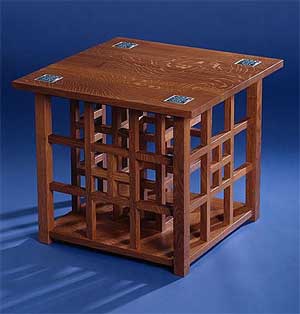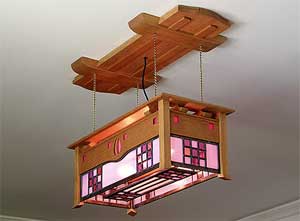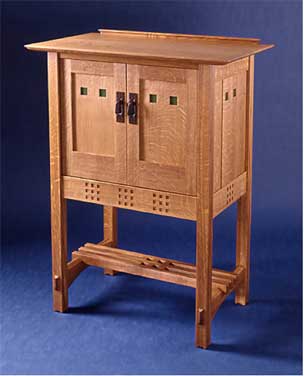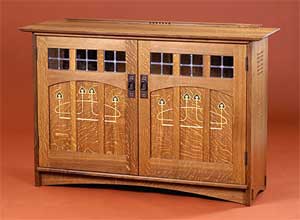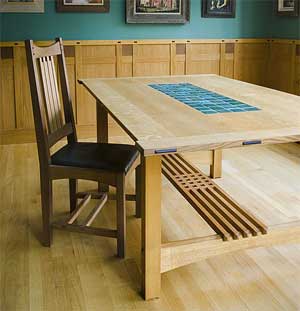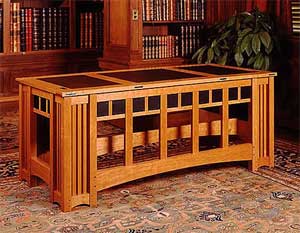
Kevin Rodel started his career with a sociology degree but, a couple of years after college, “I was disenchanted with social work and rediscovered how much I really liked working with my hands.”
Still, when Kevin discovered Arts & Crafts style furniture a few years later, it was, in part, the sociological aspect of the Arts & Crafts movement that appealed to him and led to that becoming the predominant style in his own furniture.
But first, he had to learn to do woodworking. That came about shortly after his social work disenchantment, which occurred in the mid 1970s. Kevin began to read some of the woodworking magazines that were launched around that time, and to teach himself woodworking, buying some tools setting up “a really crummy shop in the basement of the house I was sharing with some other people.”
Then, he began volunteering as a ship’s carpenter at the Philadelphia Maritime Museum to repair a barquentine (a three-masted ship, square-rigged on the foremast). Later hired on as a crew member, Kevin spent some time sailing between Philadelphia and Maine, and eventually settled in Maine and hired on at the cabinetmaking shop of Thomas Moser.
“That’s where I really started to learn,” he said. “It was a small operation at the time, and I worked there for seven years and became proficient at building furniture efficiently,” using a combination of machines and hand tools. Kevin also, he said, “got quite used to the Shaker style.”
After Thomas Moser expanded, Kevin left to open his own shop, working in post and beam construction with a local house builder for a year while he completed it. At first, he said, “When you’re self-employed, you’ll take any kind of work you can get at the beginning,” so he found himself doing a lot of Shaker work.
He was interested in doing his own design work but said he never felt successful doing designing until, in the late 1980s, he stumbled upon information about the Arts & Crafts Movement. Kevin said he found the designs comfortable and the movement, with its focus on handcrafting rather than mass production, “philosophically interesting and socially important. The reaction to the Industrial Revolution in this nineteenth century movement had a nice philosophical ring for me.”
He spent several years making furniture inspired by this historic style, including a couple of pieces Kevin says he’s particularly fond of — the Glasgow Sideboard, and the Prairie Desk. He’s made 19 of the latter over the past 20 years, including one for film critic Roger Ebert.
Today, Kevin says his designs are moving somewhat away from Arts and Crafts and becoming more original, but he does still maintain tradition in areas like the finishes he applies. “I despise staining,” he said. Kevin prefers to use techniques such as ebonizing or fuming on his pieces: “I do preindustrial methods of coloring,” he said.
He applies those methods to woods that are Forest Stewardship Council certified — a situation that came about, Kevin said, because “I always try to use really good wood.” Those good woods for him — North American species like cherry, white oak, and walnut when it’s called for — have generally come from a small sawyer, with all the boards from the same tree, and so on. “It’s a coincidence that even before FSC became popular,” his sources were following the guidelines, Kevin said — although he also notes that he has an upcoming project for a LEED-certified building. For that, he’s required to use wood that is sustainably harvested or recycled/reclaimed.
“I hope I’m contributing to the beautiful environment of someone’s home or office,” Kevin said.
He also hopes that the book he coauthored with Jonathan Binzen, Arts & Crafts Furniture: From Classic to Contemporary, has made a contribution. It’s targeted to aspiring woodworkers looking for ideas, Kevin said, and when he gets questions from such woodworkers, “I always tell them to get familiar with what has gone before, to study history. Rather than how-to stuff, I like to stress the ‘why’ of how a design came to be.”
His own designs, he said, are “hopefully lasting and appealing. I strive to create designs that are attractive and functional at the same time.”
